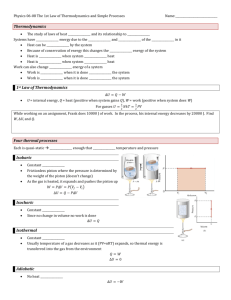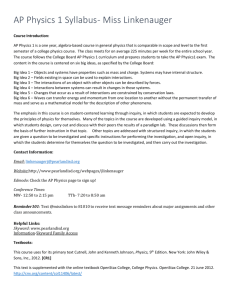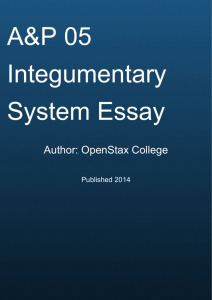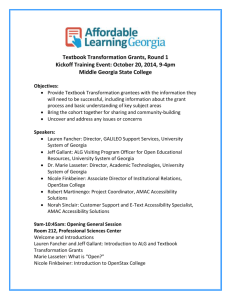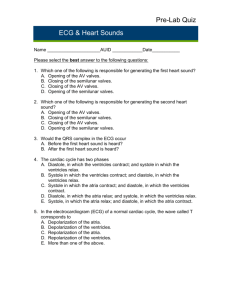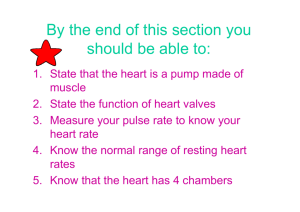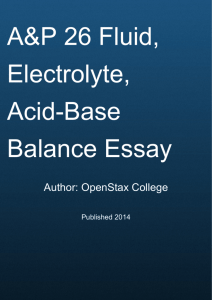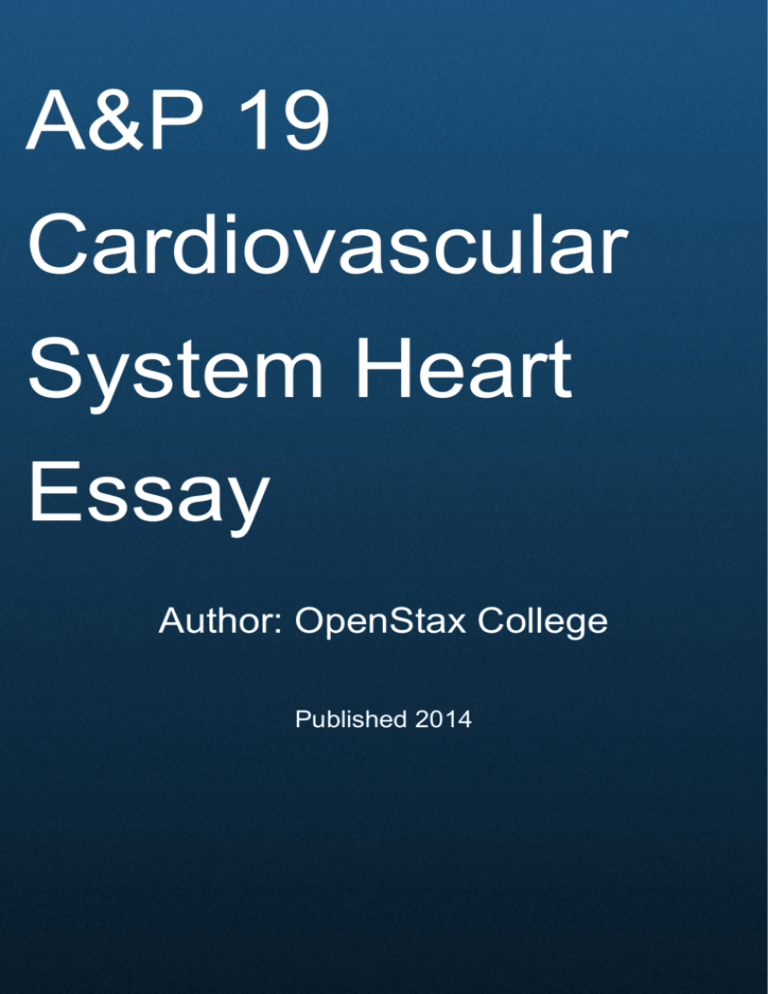
Cover Page
A&P 19
Cardiovascular
System Heart
Essay
Author: OpenStax College
Published 2014
About Us
Powered by QuizOver.com
The Leading Online Quiz & Exam Creator
Create, Share and Discover Quizzes & Exams
http://www.quizover.com
(2) Powered by QuizOver.com - http://www.quizover.com
QuizOver.com is the leading online quiz & exam creator
Copyright (c) 2009-2015 all rights reserved
Disclaimer
All services and content of QuizOver.com are provided under QuizOver.com terms of use on an "as is" basis,
without warranty of any kind, either expressed or implied, including, without limitation, warranties that the provided
services and content are free of defects, merchantable, fit for a particular purpose or non-infringing.
The entire risk as to the quality and performance of the provided services and content is with you.
In no event shall QuizOver.com be liable for any damages whatsoever arising out of or in connection with the use
or performance of the services.
Should any provided services and content prove defective in any respect, you (not the initial developer, author or
any other contributor) assume the cost of any necessary servicing, repair or correction.
This disclaimer of warranty constitutes an essential part of these "terms of use".
No use of any services and content of QuizOver.com is authorized hereunder except under this disclaimer.
The detailed and up to date "terms of use" of QuizOver.com can be found under:
http://www.QuizOver.com/public/termsOfUse.xhtml
(3) Powered by QuizOver.com - http://www.quizover.com
QuizOver.com is the leading online quiz & exam creator
Copyright (c) 2009-2015 all rights reserved
eBook Content License
OpenStax College. Anatomy & Physiology, OpenStax-CNX Web site.
http://cnx.org/content/col11496/1.6/, Jun 11, 2014
Creative Commons License
Attribution-NonCommercial-NoDerivs 3.0 Unported (CC BY-NC-ND 3.0)
http://creativecommons.org/licenses/by-nc-nd/3.0/
You are free to:
Share: copy and redistribute the material in any medium or format
The licensor cannot revoke these freedoms as long as you follow the license terms.
Under the following terms:
Attribution: You must give appropriate credit, provide a link to the license, and indicate if changes were made. You
may do so in any reasonable manner, but not in any way that suggests the licensor endorses you or your use.
NonCommercial: You may not use the material for commercial purposes.
NoDerivatives: If you remix, transform, or build upon the material, you may not distribute the modified material.
No additional restrictions: You may not apply legal terms or technological measures that legally restrict others
from doing anything the license permits.
(4) Powered by QuizOver.com - http://www.quizover.com
QuizOver.com is the leading online quiz & exam creator
Copyright (c) 2009-2015 all rights reserved
4. Chapter: A&P 19 Cardiovascular System Heart Essay
1. A&P 19 Cardiovascular System Heart Essay Questions
(5) Powered by QuizOver.com - http://www.quizover.com
QuizOver.com is the leading online quiz & exam creator
Copyright (c) 2009-2015 all rights reserved
4.1.1. Visit this site (http://openstaxcollege.org/l/heartvalve) to observ...
Author: OpenStax College
Visit this site (http://openstaxcollege.org/l/heartvalve) to observe an echocardiogram of actual heart valves
opening and closing. Although much of the heart has been "removed"
from this gif loop so the chordae tendineae are not visible, why is their presence more critical for the
atrioventricular valves (tricuspid and mitral) than the semilunar (aortic and pulmonary) valves?
•
The pressure gradient between the atria and the ventricles is much greater than that between the
ventricles and the pulmonary
trunk and aorta. Without the presence of the chordae tendineae and papillary muscles, the valves would
be blown back (prolapsed)
into the atria and blood would regurgitate.
Check the answer of this question online at QuizOver.com:
Question: Visit this site http://openstaxcollege OpenStax College Anatomy Quest
(6) Powered by QuizOver.com - http://www.quizover.com
QuizOver.com is the leading online quiz & exam creator
Copyright (c) 2009-2015 all rights reserved
4.1.2. Describe how the valves keep the blood moving in one direction.
Author: OpenStax College
Describe how the valves keep the blood moving in one direction.
•
When the ventricles contract and pressure begins to rise in the ventricles, there is an initial tendency
for blood to flow back (regurgitate) to the atria.
However, the papillary muscles also contract, placing tension on the chordae tendineae and holding
the atrioventricular valves (tricuspid and mitral) in place to prevent the valves from prolapsing and
being forced back into the atria.
The semilunar valves (pulmonary and aortic) lack chordae tendineae and papillary muscles, but do not
face the same pressure gradients as do the atrioventricular valves.
As the ventricles relax and pressure drops within the ventricles, there is a tendency for the blood
to flow backward.
However, the valves, consisting of reinforced endothelium and connective tissue, fill with blood and
seal off the opening preventing the return of blood.
Check the answer of this question online at QuizOver.com:
Question: Describe how the valves keep the blood OpenStax College Anatomy Quest
(7) Powered by QuizOver.com - http://www.quizover.com
QuizOver.com is the leading online quiz & exam creator
Copyright (c) 2009-2015 all rights reserved
4.1.3. Why is the pressure in the pulmonary circulation lower than in the ...
Author: OpenStax College
Why is the pressure in the pulmonary circulation lower than in the systemic circulation?
•
The pulmonary circuit consists of blood flowing to and from the lungs, whereas the systemic circuit
carries blood to and from the entire body.
The systemic circuit is far more extensive, consisting of far more vessels and offers much greater
resistance to the flow of blood, so the heart must generate a higher pressure to overcome this resistance.
This can be seen in the thickness of the myocardium in the ventricles.
Check the answer of this question online at QuizOver.com:
Question: Why is the pressure in the pulmonary OpenStax College Anatomy Quest
(8) Powered by QuizOver.com - http://www.quizover.com
QuizOver.com is the leading online quiz & exam creator
Copyright (c) 2009-2015 all rights reserved
4.1.4. Why is the plateau phase so critical to cardiac muscle function?
Author: OpenStax College
Why is the plateau phase so critical to cardiac muscle function?
•
It prevents additional impulses from spreading through the heart prematurely, thereby allowing the
muscle sufficient time to contract and pump blood effectively.
Check the answer of this question online at QuizOver.com:
Question: Why is the plateau phase so critical to OpenStax College Anatomy
(9) Powered by QuizOver.com - http://www.quizover.com
QuizOver.com is the leading online quiz & exam creator
Copyright (c) 2009-2015 all rights reserved
4.1.5. How does the delay of the impulse at the atrioventricular node cont...
Author: OpenStax College
How does the delay of the impulse at the atrioventricular node contribute to cardiac function?
•
It ensures sufficient time for the atrial muscle to contract and pump blood into the ventricles prior
to the impulse being conducted into the lower chambers.
Check the answer of this question online at QuizOver.com:
Question: How does the delay of the impulse at the OpenStax College Anatomy
(10) Powered by QuizOver.com - http://www.quizover.com
QuizOver.com is the leading online quiz & exam creator
Copyright (c) 2009-2015 all rights reserved
4.1.6. How do gap junctions and intercalated disks aid contraction of the ...
Author: OpenStax College
How do gap junctions and intercalated disks aid contraction of the heart?
•
Gap junctions within the intercalated disks allow impulses to spread from one cardiac muscle cell to
another, allowing sodium, potassium, and calcium ions to flow between adjacent cells, propagating the
action potential, and ensuring coordinated contractions.
Check the answer of this question online at QuizOver.com:
Question: How do gap junctions and intercalated OpenStax College Anatomy Quest
(11) Powered by QuizOver.com - http://www.quizover.com
QuizOver.com is the leading online quiz & exam creator
Copyright (c) 2009-2015 all rights reserved
4.1.7. Why do the cardiac muscles cells demonstrate autorhythmicity?
Author: OpenStax College
Why do the cardiac muscles cells demonstrate autorhythmicity?
•
Without a true resting potential, there is a slow influx of sodium ions through slow channels that
produces a prepotential that gradually reaches threshold.
Check the answer of this question online at QuizOver.com:
Question: Why do the cardiac muscles cells demonstrate OpenStax College Anatomy
(12) Powered by QuizOver.com - http://www.quizover.com
QuizOver.com is the leading online quiz & exam creator
Copyright (c) 2009-2015 all rights reserved
4.1.8. Describe one cardiac cycle, beginning with both atria and ventricle...
Author: OpenStax College
Describe one cardiac cycle, beginning with both atria and ventricles relaxed.
•
The cardiac cycle comprises a complete relaxation and contraction of both the atria and ventricles,
and lasts approximately 0.8 seconds.
Beginning with all chambers in diastole, blood flows passively from the veins into the atria and past
the atrioventricular valves into the ventricles.
The atria begin to contract following depolarization of the atria and pump blood into the ventricles.
The ventricles begin to contract, raising pressure within the ventricles.
When ventricular pressure rises above the pressure in the two major arteries, blood pushes open the
two semilunar valves and moves into the pulmonary trunk and aorta in the ventricular ejection phase.
Following ventricular repolarization, the ventricles begin to relax, and pressure within the ventricles drops.
When the pressure falls below that of the atria, blood moves from the atria into the ventricles,
opening the atrioventricular valves and marking one complete heart cycle.
Check the answer of this question online at QuizOver.com:
Question: Describe one cardiac cycle beginning with OpenStax College Anatomy
(13) Powered by QuizOver.com - http://www.quizover.com
QuizOver.com is the leading online quiz & exam creator
Copyright (c) 2009-2015 all rights reserved
4.1.9. Why does increasing EDV increase contractility?
Author: OpenStax College
Why does increasing EDV increase contractility?
•
Increasing EDV increases the sarcomeres' lengths within the cardiac muscle cells, allowing more cross
bridge formation between the myosin and actin and providing for a more powerful contraction.
This relationship is described in the Frank-Starling mechanism.
Check the answer of this question online at QuizOver.com:
Question: Why does increasing EDV increase contractility OpenStax College Anatomy
(14) Powered by QuizOver.com - http://www.quizover.com
QuizOver.com is the leading online quiz & exam creator
Copyright (c) 2009-2015 all rights reserved
4.1.10. Why is afterload important to cardiac function?
Author: OpenStax College
Why is afterload important to cardiac function?
•
Afterload represents the resistance within the arteries to the flow of blood ejected from the ventricles.
If uncompensated, if afterload increases, flow will decrease. In order for the heart to maintain
adequate flow to overcome increasing afterload, it must pump more forcefully.
This is one of the negative consequences of high blood pressure or hypertension.
Check the answer of this question online at QuizOver.com:
Question: Why is afterload important to cardiac OpenStax College Anatomy Quest
(15) Powered by QuizOver.com - http://www.quizover.com
QuizOver.com is the leading online quiz & exam creator
Copyright (c) 2009-2015 all rights reserved
4.1.11. Why is it so important for the human heart to develop early and beg...
Author: OpenStax College
Why is it so important for the human heart to develop early and begin functioning within the developing embryo?
•
The human embryo is rapidly growing and has great demands for nutrients and oxygen, while producing
waste products including carbon dioxide.
All of these materials must be received from or delivered to the mother for processing.
Without an efficient early circulatory system, this would be impossible.
Check the answer of this question online at QuizOver.com:
Question: Why is it so important for the human heart OpenStax College Anatomy
(16) Powered by QuizOver.com - http://www.quizover.com
QuizOver.com is the leading online quiz & exam creator
Copyright (c) 2009-2015 all rights reserved
4.1.12. Describe how the major pumping chambers, the ventricles, form withi...
Author: OpenStax College
Describe how the major pumping chambers, the ventricles, form within the developing heart.
•
After fusion of the two endocardial tubes into the single primitive heart, five regions quickly become
visible.
From the head, these are the truncus arteriosus, bulbus cordis, primitive ventricle, primitive atrium,
and sinus venosus.
Contractions propel the blood from the sinus venosus to the truncus arteriosus.
About day 23, the heart begins to form an S-shaped structure within the pericardium.
The bulbus cordis develops into the right ventricle, whereas the primitive ventricle becomes the left
ventricle.
The interventricular septum separating these begins to form about day 28.
The atrioventricular valves form between weeks five to eight.
At this point, the heart ventricles resemble the adult structure.
Check the answer of this question online at QuizOver.com:
Question: Describe how the major pumping chambers OpenStax College Anatomy
(17) Powered by QuizOver.com - http://www.quizover.com
QuizOver.com is the leading online quiz & exam creator
Copyright (c) 2009-2015 all rights reserved




